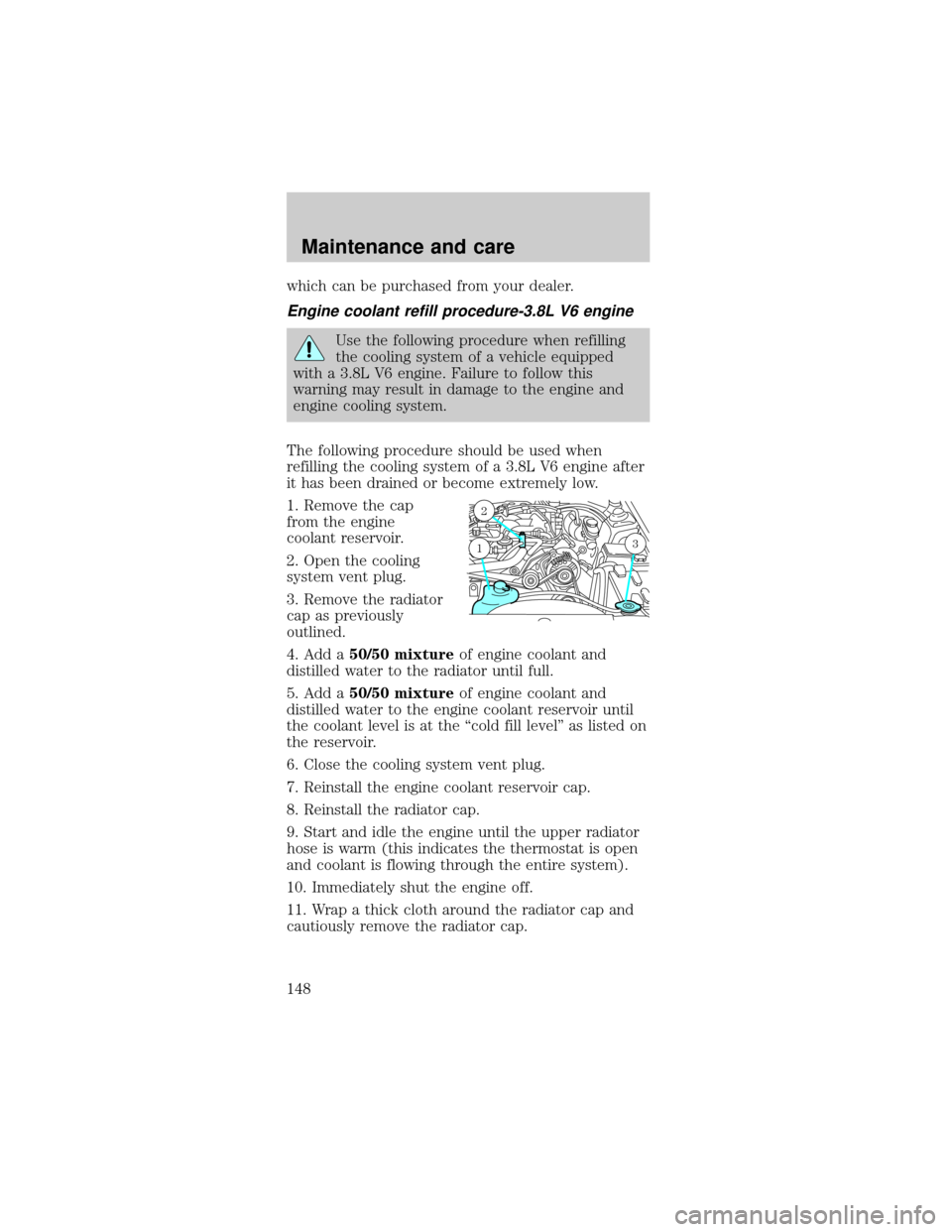2000 FORD MUSTANG warning
[x] Cancel search: warningPage 101 of 224

If it is necessary to use the above procedure to
move the gearshift lever, it is possible that a fuse
has blown or the vehicle's brakelamps are not
operating properly. Refer toFuses and relaysin the
Roadside emergencieschapter.
Do not drive your vehicle until you verify
that the brakelamps are working.
If your vehicle gets stuck in mud or snow it may be
rocked out by shifting from forward and reverse
gears, stopping between shifts, in a steady pattern.
Press lightly on the accelerator in each gear.
Do not rock the vehicle if the engine is not at
normal operating temperature or damage to
the transmission may occur.
Do not rock the vehicle for more than a few
minutes or damage to the transmission and
tires may occur or the engine may overheat.
Always set the parking brake fully and make
sure the gearshift is latched in P (Park).
Turn off the ignition whenever you leave your
vehicle.
If the parking brake is fully released, but the
brake warning lamp remains illuminated, the
brakes may not be working properly. See your
dealer or a qualified service technician.
Driving
101
Page 147 of 224

Have your dealer check the engine cooling system
for leaks if you have to add more than 1.0 liter (1.0
quart) of engine coolant per month.
If equipped with the 3.8L V6 engine, to
avoid scalding hot steam or coolant from
being released from the engine cooling system,
never remove the radiator cap from the radiator
while the engine is running or hot. Failure to
follow this warning may result in damage to the
engine's cooling system and possible severe
personal injury.
If equipped with the 4.6L V8 engine, to
avoid scalding hot steam or coolant from
being released from the engine cooling system,
never remove the pressure relief cap from the
engine coolant reservoir while the engine is
running or hot. Failure to follow this warning may
result in damage to the engine's cooling system
and possible severe personal injury.
If you must remove the pressure relief cap or
radiator cap (depending upon engine application),
follow these steps to avoid personal injury:
1. Before you remove the cap, turn the engine off
and let it cool.
2. When the engine is cool, wrap a thick cloth
around the cap. Slowly turn cap counterclockwise
until pressure begins to release.
3. Step back while the pressure releases.
4. When you are sure that all the pressure has been
released, use the cloth to turn it counterclockwise
and remove the cap.
Engine coolant drain and flush
Procedures for draining and flushing the cooling
system can be found in theCar Service Manual,
Maintenance and care
147
Page 148 of 224

which can be purchased from your dealer.
Engine coolant refill procedure-3.8L V6 engine
Use the following procedure when refilling
the cooling system of a vehicle equipped
with a 3.8L V6 engine. Failure to follow this
warning may result in damage to the engine and
engine cooling system.
The following procedure should be used when
refilling the cooling system of a 3.8L V6 engine after
it has been drained or become extremely low.
1. Remove the cap
from the engine
coolant reservoir.
2. Open the cooling
system vent plug.
3. Remove the radiator
cap as previously
outlined.
4. Add a50/50 mixtureof engine coolant and
distilled water to the radiator until full.
5. Add a50/50 mixtureof engine coolant and
distilled water to the engine coolant reservoir until
the coolant level is at the ªcold fill levelº as listed on
the reservoir.
6. Close the cooling system vent plug.
7. Reinstall the engine coolant reservoir cap.
8. Reinstall the radiator cap.
9. Start and idle the engine until the upper radiator
hose is warm (this indicates the thermostat is open
and coolant is flowing through the entire system).
10. Immediately shut the engine off.
11. Wrap a thick cloth around the radiator cap and
cautiously remove the radiator cap.
2
31
Maintenance and care
148
Page 176 of 224

²Have the items listed in your Scheduled
Maintenance Guide performed according to the
specified schedule.
The scheduled maintenance items listed in the
Scheduled Maintenance Guide are essential to the
life and performance of your vehicle and to its
emissions system.
If other than Ford, Motorcraft or Ford-authorized
parts are used for maintenance replacements or for
service of components affecting emission control,
such non-Ford parts should be equivalent to genuine
Ford Motor Company parts in performance and
durability.
Do not park, idle, or drive your vehicle in
dry grass or other dry ground cover. The
emission system heats up the engine compartment
and exhaust system, which can start a fire.
Illumination of the ªService Engine Soonº light,
charging system warning light or the temperature
warning light, fluid leaks, strange odors, smoke or
loss of engine power, could indicate that the
emission control system is not working properly.
Exhaust leaks may result in entry of harmful
and potentially lethal fumes into the
passenger compartment.
Do not make any unauthorized changes to your
vehicle or engine. By law, vehicle owners and anyone
who manufactures, repairs, services, sells, leases,
trades vehicles, or supervises a fleet of vehicles are
not permitted to intentionally remove an emission
control device or prevent it from working.
Information about your vehicle's emission system is
on the Vehicle Emission Control Information Decal
located on or near the engine. This decal identifies
engine displacement and gives some tune up
specifications.
Maintenance and care
176
Page 177 of 224

Please consult your ªWarranty Guideº for complete
emission warranty information.
Readiness for Inspection/Maintenance (I/M)
testing
In some localities, it may be a legal requirement to
pass an I/M test of the on-board diagnostics system.
If your ªCheck Engine/Service Engine Soonº light is
on, refer to the description in theWarning Lights
and Chimessection of theInstrumentation
chapter. Your vehicle may not pass the I/M test with
the ªCheck Engine/Service Engine Soonº light on.
If the vehicle's powertrain system or its battery has
just been serviced, the on-board diagnostics system
is reset to a ªnot ready for I/M testº condition. To
ready the on-board diagnostics system for I/M
testing, a minimum of 30 minutes of city and
highway driving is necessary as described below:
²First, at least 10 minutes of driving on an
expressway or highway.
²Next, at least 20 minutes driving in stop-and-go,
city-type traffic with at least four idle periods.
Allow the vehicle to sit for at least eight hours
without starting the engine. Then, start the engine
and complete the above driving cycle. The engine
must warm up to its normal operating temperature.
Once started, do not turn off the engine until the
above driving cycle is complete.
BULBS
Replacing exterior bulbs
Check the operation of the following lamps
frequently:
²Headlamps
²Tail lamps
²Brakelamps
²High-mount brakelamp
Maintenance and care
177
Page 212 of 224

Air bag supplemental
restraint system ... 75,76
and child
safety seats ............. 77
description .............. 76
disposal .................... 80
driver air bag .......... 78
indicator light ...... 9,80
operation ................. 78
passenger air bag ... 78
Air cleaner filter ..... 191
Air conditioning ........ 20
manual heating
and air conditioning
system ..................... 20
Antifreeze (see
Engine coolant) ...... 143
Anti-lock brake system
(see Brakes) ......... 95,96
Anti-theft system
warning light ............. 9
Audio system
(see Radio) ................ 23
Automatic
transmission ............ 100
driving an automatic
overdrive ............... 102
fluid, adding .......... 153
fluid, checking ...... 153
fluid,
refill capacities ...... 191
fluid,
specification .......... 194
Auxiliary
power point ............... 52
Axle
lubricant
specifications.. 193,194
refill capacities ...... 191
traction lok ............ 109
Battery ..................... 157acid, treating
emergencies .......... 157
charging system
warning light ............. 9
jumping a disabled
battery ................... 128
maintenance-free .. 157
replacement,
specifications ........ 191
servicing ................ 157
voltage gauge .......... 16
Belt minder ............... 71
Brakes ................... 95,97
anti-lock .............. 95,96
anti-lock brake
system (ABS)
warning light ...... 12,96
brake
warning light ........... 12
fluid, checking
and adding ............ 141
fluid,
refill capacities ...... 191
fluid,
specifications.. 193,194
lubricant
specifications.. 193,194
parking .................... 97
shift interlock ........ 100
Break-in period ........... 3
Capacities for
refilling fluids .......... 191
Certification Label .. 196
Child safety
restraints ................... 81
child safety belts .... 81
Child
safety seats ........... 82,83
attaching with
tether straps ........... 87
in front seat ............ 84
in rear seat .............. 84
Index
212
Page 214 of 224

Doors
lubricant
specifications ........ 193
Driving under special
conditions
through water ....... 115
Emergencies, roadside
jump-starting ........ 128
Emission
control system ......... 175
Engine ...................... 194
check engine/service
engine soon light ...... 9
cleaning ................. 187
coolant ................... 143
idle speed
control ................... 157
lubrication
specifications.. 193,194
refill capacities ...... 191
service points.. 136,137
starting after a
collision ................. 117
Engine block heater... 93
Engine oil ................ 137
checking
and adding ............ 137
dipstick .................. 137
filter,
specifications.. 140,191
recommendations... 140
refill capacities ...... 191
specifications.. 193,194
Exhaust fumes .......... 93
Floor mats ................. 53
Fluid capacities ....... 191
Foglamps ................... 48
Fuel .......................... 165
calculating fuel
economy ................ 171
cap ......................... 168
capacity ................. 191choosing
the right fuel ......... 169
comparisons with
EPA fuel economy
estimates ............... 175
detergent in fuel ... 170
filling your vehicle
with fuel .. 165,168,171
filter,
specifications.. 171,191
fuel pump shut-off
switch .................... 117
gauge ....................... 14
improving fuel
economy ................ 171
low fuel
warning light ........... 11
octane rating .. 169,194
quality .................... 170
running
out of fuel ............. 170
safety information
relating to
automotive fuels ... 165
Fuses ................. 118,119
Gas cap
(see Fuel cap) ......... 168
Gas mileage (see
Fuel economy) ........ 171
Gauges .................. 13,14
battery
voltage gauge .......... 16
engine coolant
temperature
gauge ....................... 14
engine oil
pressure gauge ....... 17
fuel gauge ................ 14
odometer ................. 15
speedometer ........... 15
tachometer .............. 15
trip odometer .......... 16
Index
214
Page 215 of 224

GAWR (Gross Axle
Weight Rating) ........ 109
definition ............... 109
driving with
a heavy load .......... 109
location .................. 109
GVWR (Gross Vehicle
Weight Rating) ........ 109
calculating ............. 109
definition ............... 109
driving with
a heavy load .......... 109
location .................. 109
Hazard flashers ....... 117
Head restraints ......... 62
Headlamps ................. 18
aiming .................... 183
bulb
specifications ........ 182
daytime
running lights .......... 18
flash to pass ............ 41
high beam ............ 8,18
replacing bulbs ..... 178
turning on and off .. 18
warning chime ........ 13
Heating ...................... 20
heating and air
conditioning
system ..................... 20
Hood ........................ 135
Ignition ..................... 194
positions of the
ignition .................... 41
removing the key .. 109
Infant seats (see
Safety seats) ........ 82,83
Inspection/maintenance
(I/M) testing ............ 177
Instrument panel
cleaning ................. 188
cluster ................. 8,188lighting up panel
and interior ............. 19
location of
components ............... 8
Jump-starting
your vehicle ............. 128
Keys
key in
ignition chime ......... 13
positions of the
ignition .................... 41
removing from
the ignition ............ 109
Lamps
bulb replacement
specifications
chart ...................... 182
cargo lamps ............. 19
daytime
running light ........... 18
fog lamps ................. 48
headlamps ........ 18,178
headlamps,
flash to pass ............ 41
instrument panel,
dimming ................... 19
interior
lamps ......... 45,181,182
replacing bulbs ..... 177
178,179,180,181
Lane change indicator
(see Turn signal) ...... 40
Lights, warning and
indicator ...................... 8
air bag ........................ 9
anti-lock
brakes (ABS) ..... 12,96
anti-theft ................... 9
brake ........................ 12
charging system ........ 9
check coolant .......... 12
high beam ................. 8
Index
215